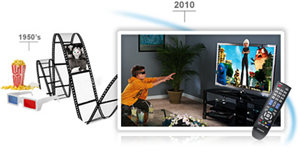 |
Choose a manufacturer to view our selection: |
|||||||||
|
|||||||||
|
|||||||||
|
Frequently Asked Questions1. What is a 3D TV and how does it work? A 3D TV is a TV that allows for home viewers to experience programs, movies, games, and other content in a stereoscopic effect. This technology adds the illusion of a third dimension to current TV display. Our e are spaced apart from each other, which means our left and right retinas see objects at slightly different angles. In real life, the brain merges these two images into a single three-dimensional image. To recreate this experience of depth on television, a 3D TV will display two separate but overlapping images of the same scene simultaneously, and at slightly different angles as well. One image is intended for the left eye, the other for the right. A pair of Active Glasses helps viewers perceive the two 2D images as one 3D image. 2. How is the new 3D TV technology different from older 3D? Most people are familiar with the anaglyph method, where a pair of glasses with lenses tinted red and blue are used to combine two images. The result seen by the viewer is discolored and usually lower quality. New 3D TV technologies allow for full color and high resolution displays. New 3D TVs use active liquid crystal shutter glasses, which work by very quickly blocking each eye in sequence. The glasses, in addition to the liquid-crystal lenses, contain electronics and batteries, that sync to the TV via an infrared signal. 3. Can everyone see 3D media? No. Between 5% and 10% of the American population suffer from stereo blindness, according to the College of Optometrists in Vision Development. They often have good depth perception, but cannot perceive the depth dimension in 3D video presentations. Some stereo-blind viewers can watch 3D material with no problem as long as they wear glasses. The image they see appears 2D. Others may experience headaches, eye fatigue, or other problems. 4. Does 3D causes headaches? For most people, viewing 3D media causes no problems after a brief orientation period lasting a few seconds as the image falls into place. For some, 3D can cause disorientation or headaches after extended periods. Too much 3D can become tiresome, abrupt camera movement can become disorienting, and certain onscreen objects can appear blurry. 5. Can viewers still watch a 3D TV without glasses? When a 3D TV is being used in its 3D setting, the on screen image will appear blurry and distorted to viewers without glasses. There is currently no technology that lets a single TV display both 2D and 3D content simultaneously. 6. Do I need to buy a new TV to experience 3D media? The TV must be able to accept a higher-bandwidth signal to display Blu-ray 3D, and older TVs can typically only accept relatively lower-bandwidth (60Hz or less) signals. This can be confusing because many non-3D LCDs have 120Hz and 240Hz refresh rates, and manufacturer marketing also mentions "600Hz" plasmas. Regardless of the "Hz" spec, these non-3D models can only handle a source that outputs at 60Hz or less via HDMI. The "conversion" to a higher rate, if applicable, occurs inside the TV itself. 3D also requires different video processing and additional hardware to send the Infrared signal to the 3D glasses. |
|
| BuyDig.com is not responsible for typographical or descriptive errors on advertised products. Prices are valid for a limited time and availability is subject to change without notice. Quantities are limited on certain products and deals are valid while supplies last. Orders will be filled on a first-come first-served basis. Shrek ® & © 2010 DreamWorks Animation L.L.C. Shrek is a registered trademark of DreamWorks Animation L.L.C. *Offer excludes Samsung 40" LEDs. |
|










 Evolution of the 3D Experience.
Evolution of the 3D Experience.

 television, a 3D TV will display two separate but overlapping images of the same scene simultaneously, and at slightly different angles as well. One image is intended for the left eye, the other for the right. A pair of Active Glasses helps viewers perceive the two 2D images as one 3D image.
television, a 3D TV will display two separate but overlapping images of the same scene simultaneously, and at slightly different angles as well. One image is intended for the left eye, the other for the right. A pair of Active Glasses helps viewers perceive the two 2D images as one 3D image.




